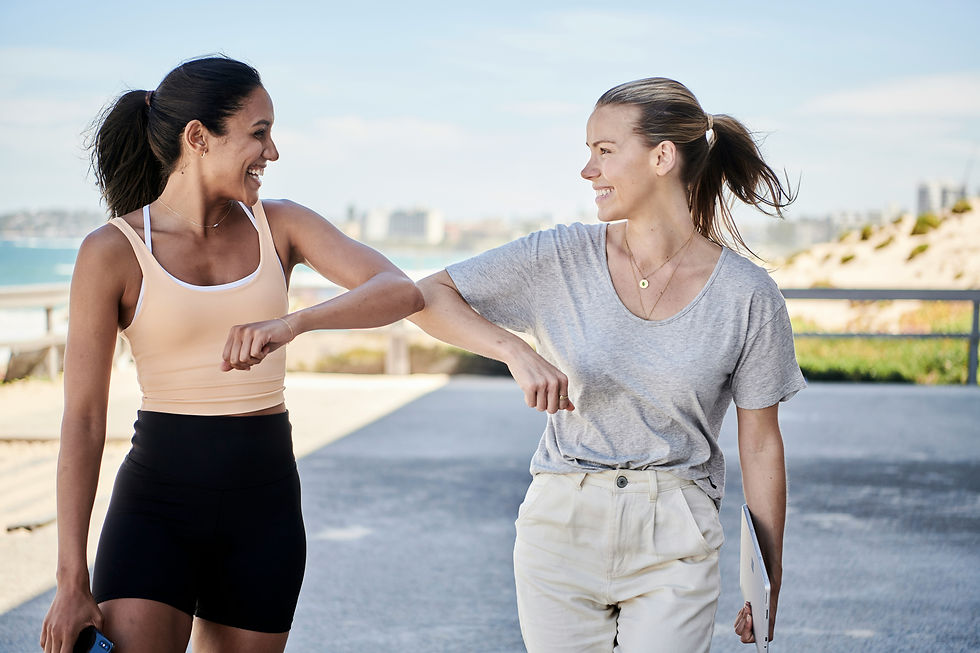Is Injury Prevention Possible? (2025)
- Jul 1
- 8 min read

Are you just one bad lift, run, or movement away from your next setback?
If you’re a high-performing woman who's disciplined, committed, and self-driven—but your body still isn’t responding—you’re not alone.
You’re doing everything “right.”
Lifting consistently
Tracking macros
Following every wellness podcast
Stretching, foam rolling, massages—you name it
But your body still feels off. You’re inflamed, tired, and stuck at the same weight. Most of my clients come to me in this exact phase. They’re not lazy. They’re not unmotivated. They’re burnt out and disconnected from the very body they’ve been trying to fix.
The truth is—injury prevention isn’t just about what you do. It’s about how much your system can handle. And unless you look at your body through a whole-person lens, you’re stuck managing symptoms instead of solving the root issue.
So let’s get real and go deeper.
Table of Contents:
The Hidden Weight of Overthinking

You might not count it as stress, but the hours you spend thinking about your next workout, planning macros, listening to self-care podcasts, and mentally critiquing your body in the mirror?
That’s mental load.
And your brain doesn’t know the difference between physical stress and cognitive stress—it responds to both the same way: with heightened cortisol and decreased recovery capacity.
According to Guillot & Collet (2008), mental imagery activates the same neural pathways as real movement. That’s a powerful tool—but also a dangerous one when it runs on autopilot.
When done with intention, visualization boosts timing, sharpens coordination, and enhances confidence. But when used compulsively—constantly analyzing, predicting, and self-correcting—it becomes what I call "mental masturbation". It creates tension, not clarity...or relief.
I experienced this personally while playing tennis—binge-watching serve variations, obsessively replaying techniques in my head, and hoping it would all click. But instead of gaining clarity, I just felt more drained. Visualization is powerful when used intentionally—but when it runs on a loop, it becomes a form of mental overexertion.
That’s why I teach my clients that their nervous system needs stillness just as much as strategy. It’s like trying to write a report after 10 back-to-back Zoom meetings. You’re at your desk, your fingers are on the keyboard, but your brain is fried. You’re present, but not productive. Your nervous system operates the same way—it needs whitespace to recover, reset, and perform.
What Happens When You Feel Disconnected

This is the one no one talks about—but it’s often the most important.
Spiritual load is the weight of disconnection—from your values, from God or your higher power, and from the present moment. It’s the internal noise that says:
“I should be doing more.”
“This isn’t enough.”
“I don’t know who I am without the hustle.”
Chevalier et al. (2012) found that grounding (i.e., reconnecting with the earth’s energy through barefoot exposure) improved wound healing, lowered cortisol, and improved sleep.
I call the antidote “Ground Yourself Biiiiish”—playful, but powerful. For me and many of my clients, this looks like:
Standing barefoot in grass
Deep breathing
Silent prayer or reflection
Just being, without needing to fix or figure anything out
This disconnect creates tension that your body feels, whether you're conscious of it or not. And one of the places that tension lives is in your fascia—the white, web-like sheath of connective tissue that wraps around your muscles, joints, and organs.
Fascia holds everything together, but it also responds to mental, emotional, spiritual, and physical stress. When you're overwhelmed, spiritually shut down, or feeling unsafe in your own life, your fascia tenses up, sticks, and stops gliding smoothly.
Think of it like putting plastic wrap on a bowl. If the wrap is crumpled, it won’t lay flat—it puckers and pulls. That’s exactly how tight or “knotted” fascia behaves. It shortens range of motion, causes muscular imbalances, and restricts efficient movement. You can stretch all day—but if your fascia is still crumpled, your body can’t move freely, and you stay stuck in patterns of pain and compensation.
Chevalier et al. (2012) found that grounding (i.e., reconnecting with the earth’s energy through barefoot exposure) improved wound healing, lowered cortisol, and improved sleep.
The antidote, I call it “Ground Yourself Biiiiish”—playful, but powerful. For me and many of my clients, this looks like:
Standing barefoot in grass
Deep breathing
Silent prayer or reflection
Just being, without needing to fix or figure anything out
When your spirit feels safe, your fascia lets go. The crumples soften. Your nervous system settles. And your body finally exhales. That’s when real healing starts.
It’s like showing up to work at a company you deeply believe in, where you feel seen and valued. You’re not just doing the job—you’re aligned with it. The same is true for your body. When your spirit is aligned, your body can stop bracing for impact.
Pain Lives in the Tissues, Not Just the Mind

Let’s talk emotional weight.
Have you ever had a moment where something stressful happened—and your body just locked up? Your shoulders curled in. Your jaw clenched. Your breath became short.
That’s your nervous system firing off a survival response. And if that happens every day—or is left unresolved—it hardwires tension into your fascia, your joints, and your movement patterns.
HRV (Heart Rate Variability) is one of the most valuable metrics for tracking your nervous system's readiness to handle stress—physical, mental, emotional, or spiritual. It measures the variability in time between your heartbeats. The higher the variability, the more adaptable and resilient your nervous system is.
Most consumer fitness devices (like Fitbit, Oura Ring, or WHOOP) display HRV on a scale that typically ranges between 0 and 100. While everyone's baseline is different, a good rule of thumb is this:
65 and up = Your body is in a resilient state and likely ready to handle a workout, challenge, or push.
Under 65 = Your nervous system is taxed. Recovery is low, and it’s a signal to back off or pivot from your planned intensity.
Under 45 = Your system is in deep fatigue or distress. This is your red zone.
I used to ignore this. There were days my HRV was under 50, but I’d still go ride my bike to work for 8–16 miles. I thought I was killing two birds with one stone (exercise and save money)—but in reality, I was killing myself. It was like inflating a balloon that was already about to pop. My legs felt heavy, like they were being pumped with air. I was depleted, not losing weight, and crying in pain.
Now, if my HRV isn’t at least 65, I check in before following through with the plan. I might swap a high-intensity lift for a walk, breathwork, or low-load movement. It’s not about being soft—it’s about being strategic. If it’s high, I know I’m ready to train harder. or according to the plan.
Plews et al. (2013) showed that low HRV correlates with poor recovery and increased injury risk.
This is also how I guide my clients. At the start of every session, I ask how they’re feeling—not just physically, but emotionally too.
Because emotional recovery is physical recovery.
Stress that goes unprocessed creates internal rigidity. And no foam roller can release that. Imagine trying to lead a team or run a meeting after a terrible night of sleep and an unresolved argument from the day before. You might show up—but you're not present. The weight you carry internally bleeds into your performance. Your body is no different.
It's Not Just About Strength, It’s About Readiness

We’ve all been conditioned to think injury is purely physical. Pull a hamstring? Stretch more. Back pain? Strengthen your core. Tight hips? Hit your mobility drills harder.
But what if the problem isn’t the area that hurts—but the system behind it?
Your body is a stress sponge. It absorbs and distributes whatever you throw at it—mental strain, lack of sleep, emotional overwhelm, nutrient depletion, and physical tension.
If you’re training on top of all that, your nervous system is constantly playing catch-up. Think of it like your work life. You can be highly organized, follow all the productivity hacks, and still feel like you’re drowning if your overall workload is unsustainable. Even the best systems collapse if the foundation isn’t stable or supported.
And even your “perfect form” can’t save you.
A 2019 study in the British Journal of Sports Medicine (Ridge et al.) found that foot-core training alone reduced injuries in runners dramatically. Why? Because the body’s foundation—your feet—absorbs and distributes force through every movement.
I have a client who came to me with knee pain that persisted no matter what he tried—stretching, massage, electrotherapy, strength training, dry needling. The turning point? We focused on his feet. Foot drills, barefoot stability, and retraining the connection between his toes and brain. In 4 weeks his knee pain disappeared. Just like that.
It wasn’t about the knees. It was about the base.
Your feet are like the roots of a tree. If they’re unstable, the rest of your body has to compensate. And compensation over time equals pain and injury.
This is why even the most advanced training protocols fail when the foundation isn’t solid. It’s no different than building a business. You can invest in branding, marketing, and strategy—but if your systems, team, or internal operations aren’t stable, the whole thing eventually collapses. I’ve seen entrepreneurs, myself included, pour themselves into the surface-level pieces while neglecting the core—and it’s the same with your body. If your foundation (your feet, your posture, your structure) isn’t prepared to support the load, things fall apart under pressure.
So... Is Injury Prevention Possible?

Yes. But not through one-size-fits-all plans or endless mobility drills.
Injury prevention is possible when you finally stop looking at your body like a machine—and start seeing it as a system.
A system that breaks when it’s:
Mentally overloaded
Spiritually disconnected
Emotionally repressed
Physically pushed too far
If you’re that woman who’s:
Always pushing through
Always “doing more”
Always chasing the next solution
Then the answer is not more hustle. It’s alignment.
Because true strength isn’t just about lifting more weight. It’s about carrying your life, your stress, your responsibilities, and still having enough left to feel alive in your own skin.
If that resonates, let’s talk.
Let’s get your body to finally feel safe, strong, and supported. Let’s build the kind of strength that holds up—not just in the gym, but in your life.
Ready to Work With Me?

If you’re ready to stop guessing and start moving with purpose—physically, mentally, emotionally, and spiritually—I offer 1:1 online coaching that goes far beyond reps and macros.
Together, we’ll assess your whole-body stress load, reprogram faulty movement patterns, and build a system that’s strong from the inside out—so you can train hard, recover well, and finally feel at home in your body.
Book your free consultation and let’s find the root—not just manage the symptom.
Contact Information
Email us at support@lumi-soul.c
Follow us for More Tips and Inspiration:
Remember, growth comes not from how hard you push but from how wisely you balance effort and recovery. Reference
Gabbett, T. J. (2016): "Excessive and rapid increases in training loads are likely responsible for a large proportion of non-contact, soft-tissue injuries."
Guillot, A., & Collet, C. (2008): Motor Imagery Enhances Performance Beyond the Imagined Action.
Plews, D. J., et al. (2013): Heart rate variability as a measure of recovery in elite athletes.
Chevalier, G., et al. (2012): Earthing: Health Implications of Reconnecting the Human Body to the Earth's Surface Electrons.
Ridge, S. T., et al. (2019): Foot-core training and its impact on injury prevention.
Frontiers in Sports and Active Living (2020): Psychological responses to injury in sports.




Comments